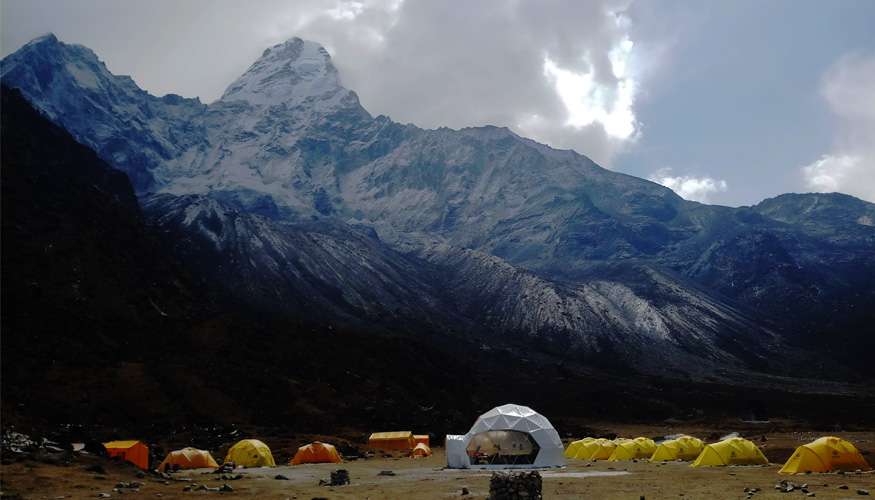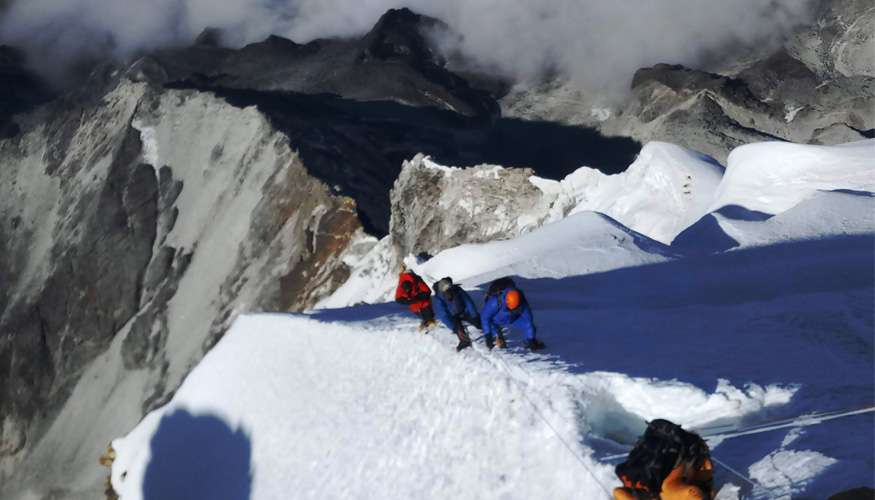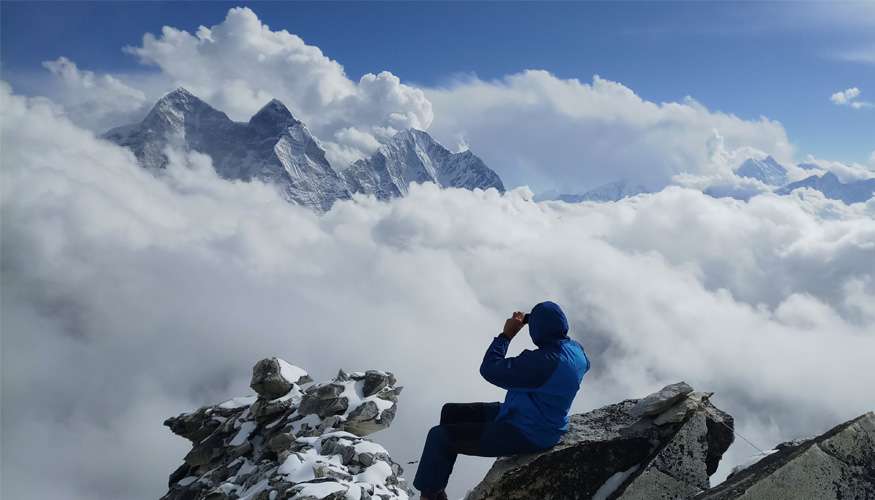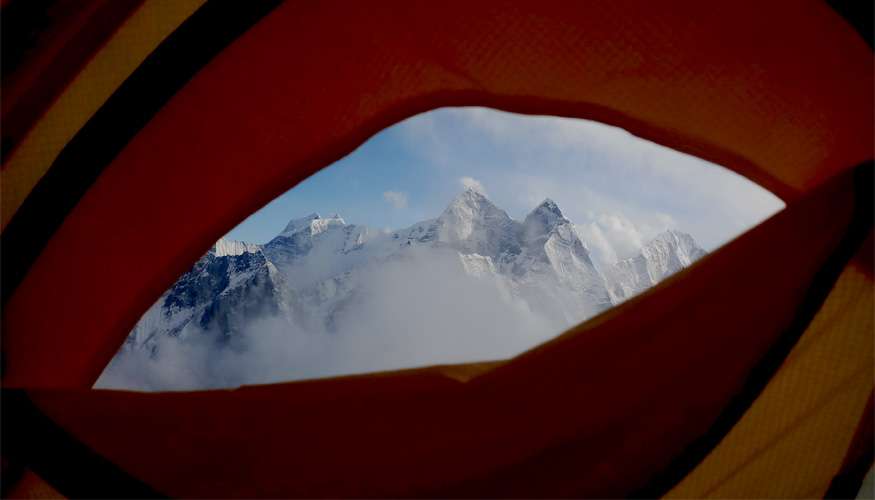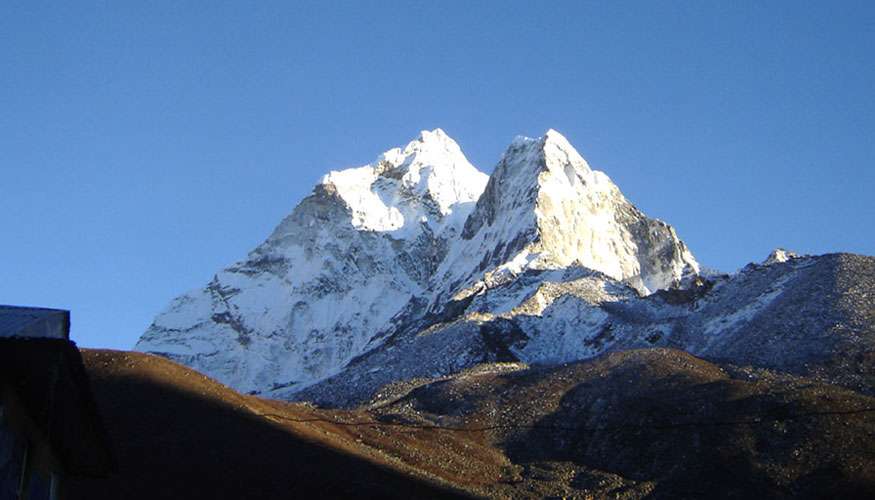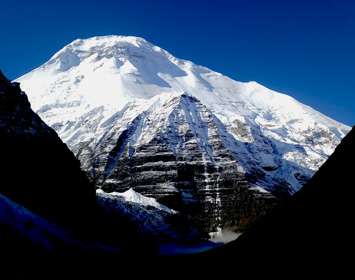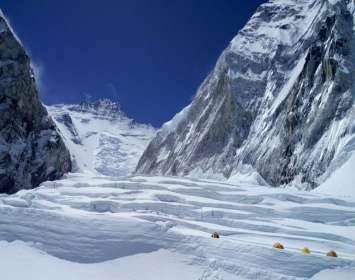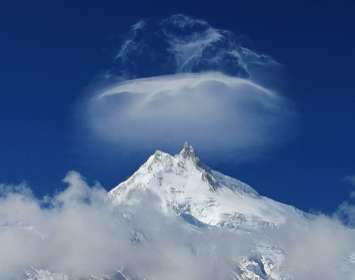Good to Know
Ama Dablam Southwest Route
Base Camp (4,600m)
Situated at this height, Ama Dablam Base Camp is the biggest grassy base camp in Nepal, where climbers usually play soccer or volleyball to spend the day and adjust with the altitude. You will be spending a long time here at the base camp. The base camp will be set with all the tents and requirements. We, Dream Peak Adventure offers separate sleeping tents to all the crew members with a common dining tent and washroom tents.
Camp I (5,700m); 5hrs
From the base camp, you will easily reach Camp I as the trail is not difficult. Still, you have to overcome a rocky section that is 100 meters long. Camp I is located at a slope of 60º. Before reaching Camp I, you will pass by a large boulder and ascend on a fourth class slab without using a fixed rope. As there are not many places to put on Camp I, you will share a sleeping tent with one of the fellow climbers.
Camp II (5,950m); 3hrs
Leaving Camp I behind, you gradually ascend on the technical section. The first part of the trail ascends along fourth class horizontal rock ridge, which is not difficult. As the exposure will increase with the increase of the altitude, the climb slowly becomes tough. Soon, you come across the Yellow Tower, which is 6 meters long. Climbing the Yellow Tower, you reach Camp II. You have to be extremely careful while moving around Camp II.
Camp III (6,200m); 2hrs
The trail ascends along the mixed terrain of ice and snow. To reach Camp III, you have to use fixed rope throughout the route for safety. Enjoying stunning views of the nearby Himalayan mountain, you reach Camp III. We will only set Camp III if you couldn't push towards the summit from Camp II. Camp III is an avalanche-prone area, therefore we will try to reduce our time here as much as possible here.
Summit (6,812m); 10hrs
From Camp III, it is 10 hours to walk to and from the summit. You will cross two dramatic but very solid snow-ice 40º+. As you will be approaching Dablam, you come across a fluted ice field (30-50º) that leads to the summit of Mt. Ama Dablam. From the stop of this finest summit, you get to see panoramic views of several Himalayan mountains including Everest.
Why go on Ama Dablam Expedition with us?
Our years of expertise along with field experience makes us the best travel partner for Ama Dablam Expedition. We provide high-quality service. Our itinerary is designed professionally and is well-planned to face any obstacles. While climbing with us, you will be assisted by experienced Sherpa guides who will help you to reach the summit smoothly. Our guides are well-trained and certified in various courses from first-aid to rescue.
Up in the Himalayas, only one thing matters that is your knowledge about the region. We give a team that is well known with the Himalayas and its behavior. Nothing can be said guaranteed up there, however, with us, you will be getting the best people who are raised in this environment, who knows what they are doing, and what is good for the entire team & you. Therefore, you will be safe with us.
Talking about other things, we offer branded gears, tents, and delicious meals during the climbing period. Along with that we also provide climbing training to our team to boost their confidence. Along with all these services, we offer genuine costs as well.
Best time to go on Ama Dablam Expedition
Autumn is the best time to go on the Ama Dablam Expedition because of the stable weather and clear views. The trail also becomes firm and walkable due to the snowfall in winter. Likewise, the trail in the lower elevation gets bloomed up with numerous wildflowers and vegetation. the vies are exceptionally gorgeous with a moderate climate.
Altitude Sickness Symptoms & Prevention
High altitude journey carries Acute Mountain Sickness (AMS) or altitude sickness with itself. You have to be very careful while gaining elevation because this is the main factor that triggers altitude sickness. And, especially on a journey like this do not hurry. Give your body enough time to adjust with the altitude and then only push towards the summit.
Below you can read about symptoms and preventive measures of altitude sickness:
Symptoms of altitude sickness:-
- headache
- nausea and vomiting
- dizziness
- tiredness
- loss of appetite
- shortness of breath
Preventive measures of altitude sickness:-
- Include an adequate number of rest days during the trek/climbing
- Avoid climbing more than 300-500 meters a day
- Make sure you're drinking enough water
- Eat a light but high-calorie diet
- Avoid alcohol
- Avoid smoking
- Inform your guide immediately so that he can take proper action on time
- Drop down to lower altitude and rest for a few days until symptoms getaway
Food & Water during Ama Dablam Expedition
While you spend the night in the villages, you will get meals as per the menu of the lodge. This region has particularly got a wide range of menu that ranges from Nepali, Continental, Tibetan, to Indian. Dishes like rice, bread, chapati, curries, veggies, egg, meat, pasta, sandwich, momo thukpa, pudding, porridge, bakery items, etc can be found.
Similarly, all the villages offer boiled drinking water. You can refill your bottle every time it gets empty. Do know that you might have to a few extra bucks to fill the water bottle. For extra safety, we recommend you to carry water purification tablets.
From base camp onwards, all the meals will be prepared and cooked by our trained team members. We offer delicious meals during the climbing period, which are high in nutrients. We will give you enough options to choose from. Along with that, we will also take care of your calories and will make sure your body is getting all the nutrients.
Accommodation during Ama Dablam Expedition
The lodge will be your accommodation in the villages. These lodges are run by the locals. The lodge here is pretty basic with a few pieces of furniture. The rooms come on a twin-sharing basis. If you are thinking to get a single room then it will be costly. As the rooms are not insulated properly, make sure to carry a nice sleeping bag with yourself to keep yourself warm in the night. Likewise, washrooms can be either private or common depending upon the place.
While climbing, you stay overnight in tents. All the tents are provided by us. We offer high-quality branded tents that will keep you warm on the high elevation. All the team members get separate sleeping tents and common dining and washroom tents.
Ama Dablam Expedition Packing List
We want you to know that you can rent or buy all the gears in Kathmandu. There are several options from medium range brands to high-end brands for all budget types.
- Clothing
- Sun hat/scarf
- Fleece jacket with wind-Stopper
- Waterproof shell jacket
- Down vest and/or jacket
- Lightweight gloves/Heavyweight gloves or mittens with a waterproof shell outer
- Light and expedition weight thermal bottoms
- Fleece/wool pants
- Waterproof (preferably breathable fabric) shell pants
- Thick, warm wool hiking socks
- Hiking boots with spare laces
- Sunglasses with UV protection
Accessories
- Sleeping bag rated to zero degrees Fahrenheit
- Trekking poles
- Headlamp
- Trek bag-pack
- Basic First Aid Kit
- Daypack
- Thermo-rest sleeping pad
- Water bottles
Climbing gears
- Climbing harness
- Ice ax
- crampons
- Mountaineering boots
- AscenderDescender/Abseil device
- Rope
- Snow bar
- Ice hammer
- Helmet (optional)
Toiletries
- Quick-drying towel/Small wash towel
- Soap (biodegradable)
- Toothbrush/paste biodegradable)
- Deodorants
- Face and body moisturizer
- Nail clippers
- Small mirror
- Tissue paper/toilet roll
- Anti-bacterial Hand wash
Extra
- Trail Map/Guide book
- Binocular
- Reading book
- Journal & Pen
- Pencils and small notebooks
- Camera with extra batteries

